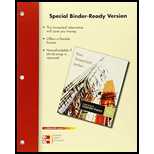
Concept explainers
Beta is often estimated by linear regression. A model often used is called the market model, which is:
Rt – Rft = αi + βi [RMt – Rft] + εt
In this regression, Rt is the return on the stock and Rft is the risk-free rate for the same period. RMt is the return on a stock market index such as the S&P 500 index, αi is the regression intercept, and βi is the slope (and the stock’s estimated beta). εt represents the residuals for the regression. What do you think is the motivation for this particular regression? The intercept, αi, is often called Jensen’s alpha. What does it measure? If an asset has a positive Jensen’s alpha, where would it plot with respect to the SML? What is the financial interpretation of the residuals in the regression?
Want to see the full answer?
Check out a sample textbook solution
Chapter 11 Solutions
ESSENTIAL OF CORP FINANCE W/CONNECT
- Can you solve this financial accounting questionarrow_forwardTABLE 9-3* Earned Income Credit Tax Year 2024 EIC percentage For earned income up to Maximum EIC Phaseout percentage None 7.65% $ 8,260 $ 632 7.65% One 34.0% 40.0% Number of Eligible Children Two Three or More 45.0% $ 12,390 $ 17,400 $ 17,400 $ 4,213 $ 6,960 15.98% 21.06% $ 7,830 21.06% For joint filers: Phaseout starts at earned income of $ 17,250 $ 29,640 $ 29,640 $ 29,640 Phaseout ends at earned income of $ 25,511 $ 56,004 $ 62,688 $ 66,819 For all other filers: Phaseout starts at earned income of Phaseout ends at earned income of $ 10,330 $ 22,720 $ 22,720 $ 22,720 $ 18,591 $ 49,084 $ 55,768 $ 59,899 * The dollar amounts in the table are subject to annual adjustments for inflation.arrow_forwardHi expert given correct answer with financial accounting questionarrow_forward
- Solve with explanation and financial accounting questionarrow_forwardIn each of the following cases, certain qualifying education expenses were paid during the tax year for individuals who were the taxpayer, spouse, or dependent. The taxpayer has a tax liability and no other credits. Required: Determine the amount of the American opportunity tax credit (AOTC) and/or the lifetime learning credit that should be taken in each instance. a. A single individual with modified AGI of $32,900 and expenses of $2,440 for a child who is a full-time college freshman. b. A single individual with modified AGI of $44,500 and expenses of $3,080 for a child who is a full-time college junior. c. A couple, married filing jointly, with modified AGI of $79,300 and expenses of $6,100 for a child who is a full-time graduate student. Allowable Credit Type of Creditarrow_forwardRequired: Determine the amount of the child tax credit in each of the following cases: a. A single parent with modified AGI of $214,700 and one child age 4. b. A single parent with modified AGI of $79,300 and three children ages 7, 9, and 12. c. A married couple, filing jointly, with modified AGI of $409,233 and two children ages 14 and 16. d. A married couple, filing jointly, with modified AGI of $133,355 and one child age 13. Child Tax Credit Allowedarrow_forward
 Intermediate Financial Management (MindTap Course...FinanceISBN:9781337395083Author:Eugene F. Brigham, Phillip R. DavesPublisher:Cengage Learning
Intermediate Financial Management (MindTap Course...FinanceISBN:9781337395083Author:Eugene F. Brigham, Phillip R. DavesPublisher:Cengage Learning


